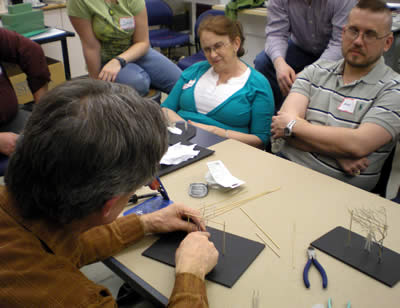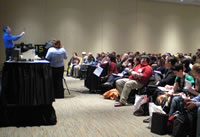 |  |  | |
News & Notices
News From:
Commissions
Conference & Stage Expo
For the Record
 | Those attending the Scene Design Commission's Professional Development Workshop, From Model to Monumental, at the 2009 Annual Conference & Stage Expo in Cincinnati, Ohio had the opportunity to observe a master at work. Later in the PDW they had the opportunity to have the experience hands-on. Photos/Mark Wethington | |
| Modeling with the Masters The “Luck of the Irish” was with the participants of the From Model to Monumental PDW on St. Patrick’s day this past March. All had the good fortune to be learning from some of the best scenic modelers out there. And for those that couldn’t make the early start to the 49th Annual USITT Conference, they certainly showed up for the encore! The participants of the model making PDW, From Model to Monumental, began at 9 a.m. for this day-long intensive workshop. Tom Umfrid of the University of Cincinnati, College Conservatory of Music - Theatre Design and Production, started the day going through his process of using Google SketchUp and Adobe Photoshop in conjunction with physical models as a communication tool between the director and the designer. He gave several examples of what he calls Sketch Models and explained the steps in the process that he uses when creating them. The next presenter was Brian Ruggaber, also of UC-CCM, who got the participants hands dirty working with brass and soldering techniques. Mr. Ruggaber helped demystify the seemingly daunting challenge of working with brass soldering techniques with a show-and-tell demonstration of cutting and bending the metal. He then demonstrated the tools and materials needed for soldering brass to create visually delicate but physically strong model components. The class then broke out into individual participants practicing the techniques that were taught. Brian and others were on hand to help with individual instruction as we approached the lunch hour.
For those who were not able to attend the full day PDW, Mr. Shortt gave his USITT colleagues a curtain call on Thursday with a session titled Quick & Dirty Model-making. Huge crowds turned out for this conference session and even the standing-room-only areas were packed with conference attendees. With the help of a video screen, Paul was able to talk and walk the audience through many of his models and the techniques he uses to build them. But more than that Paul discussed some of his design philosophies and tales from his past. Participants in the PDW were able to take with them the materials that they used during the workshop along with handouts from the presenters detailing the techniques that were presented. A handout was also available at the conference session. All considered, there was plenty of exciting information for those interested in model making and how models are used in the design process at this year’s USITT Conference. | ||
United States Institute for Theatre Technology, Inc.: © 2009 Volume XLIX, Number 6
 After lunch, Paul Shortt, Professor Emeritus of UC-CCM took participants through his process of using models in his process of designing. Using many examples of models from past productions, he showed how a model can be used as a collaborative tool in the discovery process of design and not just as a finished representation of a completed work. Later in the day, Mr. Shortt divulged some of his favorite tricks and techniques that he uses for creating his models including using picture hanging wire as a starting point for creating vines and also using hot glue as a sculpting medium. The participants even got a chance to explore these techniques in their full scale applications up in the CCM scene shop.
After lunch, Paul Shortt, Professor Emeritus of UC-CCM took participants through his process of using models in his process of designing. Using many examples of models from past productions, he showed how a model can be used as a collaborative tool in the discovery process of design and not just as a finished representation of a completed work. Later in the day, Mr. Shortt divulged some of his favorite tricks and techniques that he uses for creating his models including using picture hanging wire as a starting point for creating vines and also using hot glue as a sculpting medium. The participants even got a chance to explore these techniques in their full scale applications up in the CCM scene shop.